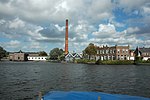Turkish Airlines Flight 1951 (also known as the Poldercrash or the Schiphol Polderbaan incident) was a passenger flight that crashed during landing at Amsterdam Schiphol Airport, the Netherlands, on 25 February 2009, resulting in the deaths of nine passengers and crew, including all three pilots.
The aircraft, a Turkish Airlines Boeing 737-800, crashed into a field about 1.5 km (0.9 mi) north of the Polderbaan runway (18R), prior to crossing the A9 motorway inbound, at 09:26 UTC (10:26 CET), having flown from Istanbul, Turkey. The aircraft broke into three pieces on impact. The wreckage did not catch fire.The crash was caused primarily by the aircraft's automated reaction, which was triggered by a faulty radio altimeter. This caused the autothrottle to decrease the engine power to idle during approach. The crew noticed this too late to take appropriate action to increase the thrust and recover the aircraft before it stalled and crashed. Boeing has since issued a bulletin to remind pilots of all 737 series and BBJ aircraft of the importance of monitoring airspeed and altitude, advising against the use of autopilot or autothrottle while landing in cases of radio altimeter discrepancies.A 2020 investigation by The New York Times found that the Dutch investigation into the crash "either excluded or played down criticisms" of Boeing following pressure from Boeing and US federal safety officials, who instead "emphasized pilot error as a factor ... rather than design flaws."










